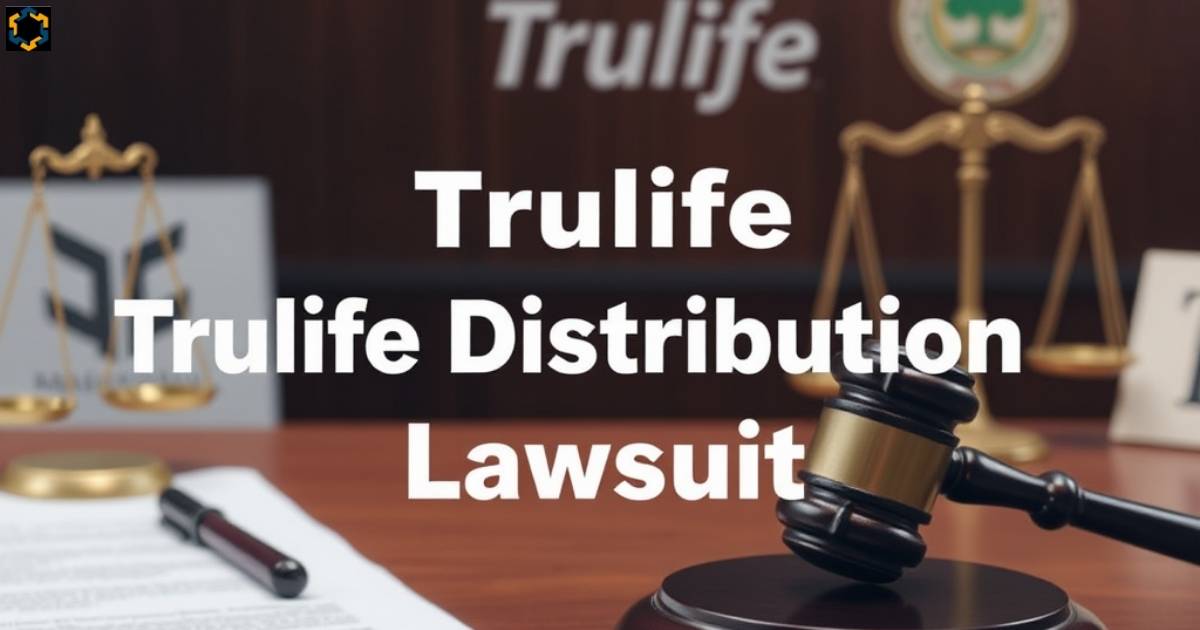Legal battles in the business world can shape industry standards and redefine competition. The Trulife Distribution lawsuit is one such case, drawing attention due to its high-stakes allegations. Accusations of trade secret theft, deceptive practices, and unfair competition have fueled this intense legal dispute.
This lawsuit is more than just a corporate clashit raises critical questions about business ethics, intellectual property protection, and fair market competition. As the case unfolds, its outcome could impact not only Trulife Distribution but also industry regulations and competitive strategies. Understanding the details of this lawsuit is essential for businesses aiming to protect their proprietary information and uphold ethical standards.
Background of the Trulife Distribution Lawsuit

The Trulife Distribution lawsuit stems from a heated legal battle involving trade secrets, unfair competition, and business ethics. The dispute began when Nutritional Products International (NPI) accused Trulife Distribution of misusing confidential information. Allegations include the unauthorized use of proprietary strategies, misleading marketing tactics, and deceptive business practices.
The lawsuit has raised concerns about intellectual property rights and corporate transparency in the industry. Companies rely on exclusive distribution strategies and client relationships to maintain a competitive edge. When these are allegedly exploited, legal action becomes inevitable. This case highlights the growing importance of compliance with business laws and ethical competition in today’s market.
Key Players in the Trulife Distribution Lawsuit
- Trulife Distribution – Founded by Brian Gould, this company specializes in brand distribution and helping businesses enter the U.S. market. Trulife is at the center of the lawsuit due to allegations of misappropriating trade secrets and engaging in deceptive marketing practices.
- Nutritional Products International (NPI) – A well-established company led by Mitch Gould. NPI assists brands in expanding globally, and they claim that Trulife used their proprietary strategies and client success stories to mislead clients and gain market share.
- Brian Gould – The founder of Trulife Distribution and former executive at NPI. His role in the lawsuit revolves around allegations of unfair competition and confidential information misuse.
- Mitch Gould – The head of NPI and father of Brian Gould. As the leader of NPI, he spearheads the legal actions against Trulife, claiming damage to their business and reputation.
- Legal Teams – Both companies have hired experienced litigation experts and intellectual property lawyers to represent their interests in this high-stakes case, making it a significant business law dispute.
See More: What Type Of Lopalapc2547: A Complete Guide To Its Uses And Features
The Genesis of the Trulife Distribution Lawsuit

The Trulife Distribution lawsuit began when Nutritional Products International (NPI) noticed striking similarities in business strategies, marketing materials, and client outreach between the two companies. Brian Gould, a former NPI executive, launched Trulife Distribution, which quickly gained traction in the brand distribution industry. However, NPI alleged that Trulife’s rapid success was due to misappropriation of confidential business information.
Concerns escalated when Trulife Distribution allegedly used misleading case studies, trade secrets, and deceptive branding practices. NPI viewed this as a direct violation of intellectual property rights and fair competition laws. This conflict led to a high-profile legal dispute, sparking debates about corporate ethics and legal accountability in competitive industries.
Specific Allegations Against Trulife Distribution
NPI’s lawsuit outlines several serious accusations against Trulife Distribution. One key claim is misrepresentation of performance, where Trulife allegedly used NPI’s case studies to mislead potential clients. This tactic, if true, could have unfairly influenced customer decisions.
Another allegation involves the misuse of email addresses, where Trulife reportedly created addresses resembling those of NPI. This could have confused clients, making them believe they were still working with NPI. Additionally, violations of trade laws are cited, including the unauthorized use of proprietary business strategies.
Legal Proceedings and Key Developments
The legal proceedings in the Trulife Distribution lawsuit have seen significant developments. Both parties have filed motions, made claims, and presented evidence to the court. The lawsuit is complex, involving issues of trade secrets, unfair competition, and intellectual property. Below is a table outlining the key events and progress in the legal process:
| Event | Description | Date/Status |
| Lawsuit Filed | NPI files the initial complaint against Trulife Distribution, alleging trade secret theft. | May 2022 |
| Defendant’s Response | Trulife denies all claims and files a motion to dismiss, arguing no wrongful actions took place. | June 2022 |
| Court Hearings | Several court hearings take place to discuss evidence, including the misuse of client materials. | Ongoing through 2023-2024 |
| Discovery Phase | Both parties present discovery documents, including emails and marketing materials. | Completed in 2024 |
| Pre-Trial Motions | Trulife files for a summary judgment, while NPI seeks injunctive relief to prevent further use of confidential information. | Expected in 2025 |
The Potential Impact of the Trulife Distribution Lawsuit
The Trulife Distribution lawsuit could have wide-reaching consequences for both the companies involved and the broader industry. As the case progresses, several key impacts are likely to emerge. These could affect business operations, market competition, and intellectual property protections across sectors.
- Reputation Damage for Trulife: If found guilty, Trulife Distribution could face significant damage to its reputation, causing potential clients and partners to reconsider their association.
- Financial Consequences: Both companies may face costly legal fees and, depending on the outcome, financial penalties for violating trade laws or intellectual property rights.
- Industry Standards for Trade Secrets: This lawsuit may set new legal precedents for the protection of business secrets and the importance of ethical competition.
- Increased Scrutiny of Marketing Practices: The case may lead to greater regulatory scrutiny on how companies present their performance and client success stories in the marketplace.
- Corporate Accountability: The lawsuit underscores the need for companies to maintain transparency and follow fair business practices to avoid legal challenges and public backlash.
The Bigger Picture: What This Means for Industry Practices
The Trulife Distribution lawsuit highlights critical issues that could reshape industry practices. Intellectual property protection, trade secrets, and ethical competition are now at the forefront of business discussions. If Trulife is found guilty of using misappropriated client materials and deceptive marketing tactics, it could lead to stricter regulations across the distribution sector.
Companies will likely face greater scrutiny regarding the use of proprietary information and business practices. This case also serves as a reminder for businesses to uphold transparency and ensure they follow fair trade regulations. The outcome of this lawsuit could set a legal precedent for future industry standards, particularly regarding confidentiality and corporate accountability.
See More: Blog Home Ideas Thehometrotters: Expert Tips For A Dreamy Home Makeover
The Road Ahead: Trulife Distribution’s Journey Post-Lawsuit
Regardless of the lawsuit’s outcome, Trulife Distribution will need to rebuild its reputation. If the court rules against Trulife, it may face financial penalties and operational restrictions. This could impact its ability to attract new clients and maintain current partnerships.
If Trulife successfully defends itself, it must still address public concerns. Rebuilding trust in the industry will require transparency and ethical business practices. The company’s future will depend on how it navigates the post-lawsuit challenges.
Conclusion
The Trulife Distribution lawsuit is more than just a legal battle; it is a case study in corporate competition. Allegations of trade secret violations and deceptive practices have raised important industry questions. The court’s decision could influence business ethics and legal standards.
Companies must learn from this dispute to avoid similar conflicts. Protecting intellectual property and maintaining ethical practices are essential in today’s market. Whether Trulife prevails or not, this lawsuit will leave a lasting impact on the industry.
FAQ’s
How Will the Trulife Distribution Lawsuit Affect Future Legal Precedents?
The outcome of this lawsuit could set important legal precedents regarding the protection of trade secrets. It will likely influence how businesses handle confidential information in future disputes.
What Are the Key Legal Considerations in Trade Secret Cases?
In trade secret cases, the court typically examines whether the confidential information was improperly used or disclosed. Intellectual property laws play a crucial role in these cases.
Could This Lawsuit Affect the Business Models of Competitors?
Yes, competitors may reassess their business models, especially regarding confidentiality agreements and ethical marketing practices. The case could encourage more rigorous industry regulations.
How Long Could the Trulife Distribution Lawsuit Last?
Given the complexity of the case, it could last for several months or even years. Court delays and ongoing pre-trial motions may extend the litigation period.
What Could Be the Financial Consequences of the Lawsuit?
Both Trulife Distribution and NPI may face significant legal fees and potential fines if the court rules in favor of the allegations. Reparations for damages could also be a possibility.

Riddhi Shanishchara, an expert in technology and SEO, shares 100% accurate and thoroughly researched tech insights at TechyMirrors. Stay updated with the latest trends and expert analysis.










